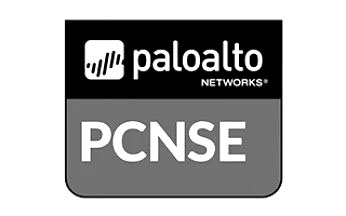
Palo Alto Networks Certified Network Security Engineer (PCNSE)
| Required Exam PCNSE-8 |
Recommended Training Palo Alto Networks – PCNSE |
Overview
WHAT YOU’ll LEARN IN THIS COURSE?
PaloAlto firewalls are true Next Generation firewalls built from the ground up to address legacy firewalls issues. It is the first firewall platform to make decisions based on applications not just ports and protocols. This class guide you through the configuration of different features and how to practice on VMware. We willcovers many topics required for PCNSE7 or PCNSE8 exams and new topics are added frequently.
This course dives deeper into Palo Alto firewalls policies and network configuration to give the students a clear understanding on several topics. Topics covered include Security Policies configuration, SSL Decryption, Routing configuration, IPsec configuration, IPv6 configuration, High Availability configuration, QoS and other real world configuration examples.
We are providing onsite and online class will help in preparing the student for the PCNSE certification by covering topics in the depth that Palo Alto expects the candidates to know.
TECHNOLOGY AREAS
Core Network Security
WHO SHOULD ATTEND?
Security Professionals responsible for designing, administration, supporting enterprise security infrastructure using PaloAlto may take this course to enhance their capabilities.
Security Professionals aspiring to appear for PCNSE8 certification exam can take this course for a methodical & through preparation for the exam.
PREREQUISITE
Students needs to be familiar with firewall concepts
Students needs to understand Networking Fundamentals
Students need to understand basic networking
Course Outline
- Understand Palo Alto Firewalls Deployment Methods
- Understand how to deploy Palo Alto Firewalls in VMware
- Understand Palo Alto Firewalls Security Policies
- Understand Palo Alto Firewalls NAT configuration
- Understand Palo Alto Firewalls Network Configuration
- Understand User ID Integration
- Configure User ID integration using User ID Agent
- Configure Captive Portal to authenticate users
- Understand Captive Portal different methods including, redirection, transparent and SSO with examples
- Understand the difference betwen NAT Source, Destination, UTurn
- Understand security zones and traffic processing in PaloAlto Firewalls
- Understand the packet flow through the PaloAlto Firewalls
- Understand Threat Prevention capabilities of the PaloAlto Firewalls
- Understand AntiSpyware, AntiVirus, IPS configuration
- Understand AntiySpyware and DNS Sinkholing
- Configure AntiSpyware, Antivirus and IPS
- Understand PaloAlto firewall AntiSpyware policy using example configuration
- Understand how to configure wildfire
- Understand how to configure Data Leakage Protection
- Configuring SSL Decryption
- Understand SSL Decryption
- Understand SSL decryption using a PaloAlto firewall SSL decryption example
- Understand how to prevent Split Brain situation with firewalls in Active / Passive HA
- PaloAlto Firewalls U-turn NAT configuration example
- Understand the difference between Inbound and Outbound proxy
- Understand the concept of Virtual Routers
- Configuration of BGP and OSPF example
- Configuration of multiple ISP with different failover scenarios
- Configuration of policy based forwarding using different scenarios
- Configure VPN IPSEc L2L tunnel on Paloato Firewall with different scenarios
- Understand the difference between IKEv1 and IKEv2 and how to deploy Palo Alto firewall with IKEv2 and the benefits
- Understand the difference between IKEv1 main mode and aggressive mode with scenarios
- Understand IKE PFS and how to configure it
- UnderstISEand and Configure High Availability Active / Passive
- Understand and Configure High Availability Active / Active with Floating IP Arp load sharing
- Understand Active Active NAT configuration with examples
- Understand and Configure IPv6 on PaloAlto Firewalls
- Understand how to deploy DHCPv6 Relay on PaloAlto firewalls
- Understand and Configure IPv6 on Palo Alto firewalls with examples.
- Understand How to configure IPV6 NPTv6 and NAT64
- Understand how to configure Palo Alto firewall in Azure with example
- Understand Panorama Concepts, device groups, templates, template stacks
- Understand QoS configuration Concepts and how you can configure QoS Marking
- Understand QoS classification and markings
- Understand QoS for IPSEc tunnel, bidirectional QoS enforcement, QoS markings and QoS copy Tos Header
- Understand how to deploy Palo Alto firewall in Google Cloud

